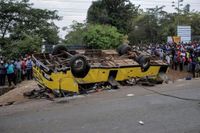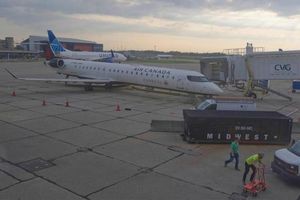A devastating bus crash in southwestern Kenya has left the nation reeling, after a vehicle transporting mourners from a funeral overturned and plunged into a ditch, killing at least 25 people and injuring dozens more. The tragedy occurred on Friday, August 8, 2025, along the Kisumu-Kakamega Highway, a stretch of road notorious for fatal accidents, according to multiple reports from the BBC, Associated Press, and The Independent.
The bus, a secondary school vehicle being used for funeral transport, was carrying relatives and friends back from a burial ceremony at Nyahera to Nyakach, a journey of roughly 62 kilometers (about 38.5 miles). The passengers were believed to be members of the same extended family, returning home after paying their last respects. As the bus neared Kisumu, witnesses and police say the driver lost control while approaching a roundabout at high speed, causing the bus to veer off the road and overturn into a ditch.
"The driver lost control of the vehicle while approaching a roundabout at high speed and the bus overturned," Peter Maina, regional traffic officer in Nyanza province, told Associated Press. The crash left a horrifying scene: police reported that 10 women, 10 men, and a 10-year-old girl died at the site, while four more passengers succumbed to their injuries in hospital. At least 20 other passengers were injured, five of them seriously, with the initial count of injured rising to 29 as more details emerged.
The magnitude of the loss has stunned the local community. According to BBC, Kenya’s Ministry of Health issued an urgent call for blood donations to help treat survivors and extended its “condolences to the bereaved.” The Ministry also urged all motorists to exercise greater caution on the nation’s roads, especially in light of the country’s ongoing struggle with fatal accidents. In a statement posted to X (formerly Twitter), Kenyan President William Ruto called for authorities to swiftly “book those responsible for any acts of negligence leading to the accident and address all traffic violations to ensure road safety across the country.”
The National Transport and Safety Authority of Kenya has pledged to support a comprehensive investigation into the cause of the crash. While the full details are still under review, police and traffic officials have pointed out that speeding and poor road conditions are common factors in such tragedies. Roads in Kenya and much of East Africa are often narrow, riddled with potholes, and poorly maintained, making them hazardous for drivers and passengers alike. “Road accidents are common in Kenya and the wider East African region, where roads are often narrow and in poor condition,” The Independent reported, echoing concerns voiced by local authorities.
Friday’s disaster is only the latest in a series of deadly incidents on Kenyan roads. Earlier in the same week, a light aircraft belonging to a medical charity crashed in a densely populated area of Nairobi, killing six people and injuring two others, as reported by Reuters. Just a day before the funeral bus crash, nine people died when a bus collided with a train at a railway crossing in the town of Naivasha, Nakuru County. The victims were workers on their way to their jobs when their bus was struck at the crossing, according to police statements cited by Associated Press and The Independent. And on Saturday, August 3, another accident near Nairobi claimed the lives of seven people, further highlighting the perilous state of road safety in the country.
Statistics paint a grim picture. Between 2020 and 2021, road deaths in Kenya surged by more than 20%, with over 4,500 people killed and more than 16,000 injured in 2021 alone, according to official figures shared by the BBC. Police routinely cite speeding, reckless driving, and the poor state of infrastructure as leading causes of these fatalities. “Police often blame speeding drivers for road accidents,” Associated Press noted, a sentiment echoed by regional traffic enforcement officers in the wake of the latest crash.
The impact of this particular accident has been amplified by the fact that the victims were returning from a funeral, compounding grief with an additional, tragic loss. Local leaders and health officials have called for urgent reforms. Fredrick Ouma Oluga, principal secretary in charge of medical services, told The Independent that the crash “shocked many in the region, sparking renewed calls for tougher road safety measures.” Community members, still reeling from the loss, have joined the chorus demanding change. The Ministry of Health’s plea for a blood drive underscored the strain that repeated mass-casualty incidents are placing on Kenya’s already stretched health system.
In response, the government has pledged to crack down on traffic violations and enforce stricter safety standards. President Ruto’s call for accountability was clear: “Authorities must quickly book those responsible for any acts of negligence leading to the accident and address all traffic violations to ensure road safety across the country.” The National Transport and Safety Authority has committed to supporting investigations and implementing any recommended reforms.
Yet, as many Kenyans know too well, promises of reform have often followed in the wake of tragedy, only to fade as time passes. The Kisumu-Kakamega Highway, where this latest disaster occurred, has long been known for its deadly reputation. Despite repeated warnings and previous accidents, dangerous driving and poor maintenance remain endemic. “Road accidents are not uncommon in Kenya, as well as in the wider East African region, where roads are often narrow and in poor condition,” Associated Press reported, highlighting a challenge that is both local and regional in scope.
For the families affected by Friday’s crash, the pain is immeasurable. The bus, intended to bring loved ones home after a somber occasion, became the site of yet another tragedy. As Kenya mourns, the hope is that this incident will galvanize real action—tougher enforcement, better infrastructure, and a renewed commitment to public safety—so that fewer families must endure such heartbreak in the future.
The aftermath of this catastrophe has once again placed Kenya’s road safety crisis in the national spotlight, demanding answers and accountability. Whether this latest tragedy will finally spur lasting change remains to be seen, but for now, a nation grieves, and a community is left searching for solace amid overwhelming loss.




